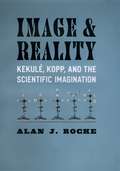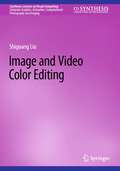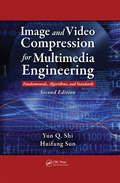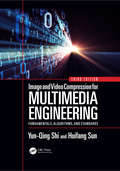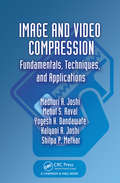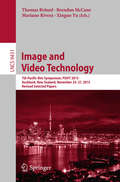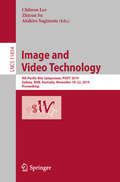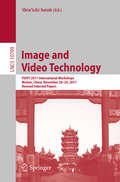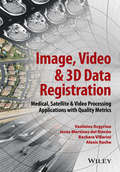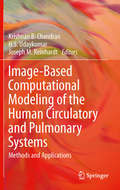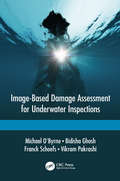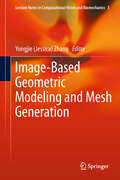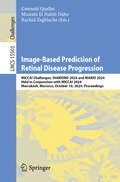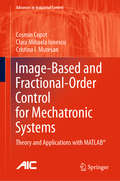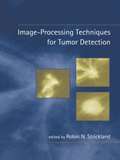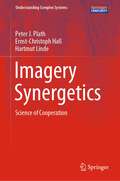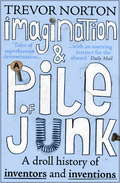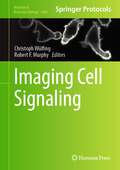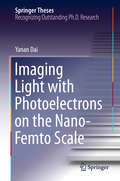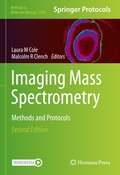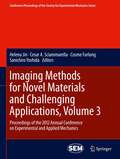- Table View
- List View
Image and Reality: Kekule, Kopp, and the Scientific Imagination
by Alan J. RockeNineteenth-century chemists were faced with a particular problem: how to depict the atoms and molecules that are beyond the direct reach of our bodily senses. In visualizing this microworld, these scientists were the first to move beyond high-level philosophical speculations regarding the unseen. In Image and Reality, Alan Rocke focuses on the community of organic chemists in Germany to provide the basis for a fuller understanding of the nature of scientific creativity. Arguing that visual mental images regularly assisted many of these scientists in thinking through old problems and new possibilities, Rocke uses a variety of sources, including private correspondence, diagrams and illustrations, scientific papers, and public statements, to investigate their ability to not only imagine the invisibly tiny atoms and molecules upon which they operated daily, but to build detailed and empirically based pictures of how all of the atoms in complicated molecules were interconnected. These portrayals of “chemical structures,” both as mental images and as paper tools, gradually became an accepted part of science during these years and are now regarded as one of the central defining features of chemistry. In telling this fascinating story in a manner accessible to the lay reader, Rocke also suggests that imagistic thinking is often at the heart of creative thinking in all fields. Image and Reality is the first book in the Synthesis series, a series in the history of chemistry, broadly construed, edited by Angela N. H. Creager, John E. Lesch, Stuart W. Leslie, Lawrence M. Principe, Alan Rocke, E. C. Spary, and Audra J. Wolfe, in partnership with the Chemical Heritage Foundation.
Image and Signal Processing
by Alamin Mansouri Fathallah Nouboud Alain Chalifour Driss Mammass Jean Meunier Abderrahim ElmoatazThis book constitutes the refereed proceedings of the 7th International Conference, ICISP 2016, held in May/June 2016 in Trois-Rivières, QC, Canada. The 40 revised full papers were carefully reviewed and selected from 83 submissions. The contributions are organized in topical sections on features extraction, computer vision, and pattern recognition; multispectral and color imaging; image filtering, segmentation, and super-resolution; signal processing; biomedical imaging; geoscience and remote sensing; watermarking, authentication and coding; and 3d acquisition, processing, and applications.
Image and Video Color Editing (Synthesis Lectures on Visual Computing: Computer Graphics, Animation, Computational Photography and Imaging)
by Shiguang LiuThis book covers image and video color editing research advances over the last two decades. Bringing readers up to speed on digital image and video editing techniques and research, the book delves into an area that has attracted much attention from researchers due to the rapid development of computer graphics and the widespread prevalence of digital cameras and mobile phones in daily life. Readers will get a comprehensive overview of the theory and application of color transfer, emotional color transfer, colorization, decolorization, and style transfer in altering still and moving digital images. Despite the existence of professional image editing software that can complete complex image editing work, the skills required to achieve satisfactory editing results can be prohibitive, and even professional image editors need to spend a lot of time developing and maintaining aptitude in a niche tool. Instead, the book explores image and video editing techniques that are simple and effective alternatives to such editing software that professional and amateur image editors can utilize. The book focuses on color as one of the most important features of an image or video. Image and video color editing aims to dramatically alter source images suitable for a wide range of applications.
Image and Video Compression for Multimedia Engineering: Fundamentals, Algorithms, and Standards (Second Edition) (Image Processing Series)
by Yun Q. Shi Huifang Sun<p>Multimedia hardware still cannot accommodate the demand for large amounts of visual data. Without the generation of high-quality video bitstreams, limited hardware capabilities will continue to stifle the advancement of multimedia technologies. Thorough grounding in coding is needed so that applications such as MPEG-4 and JPEG 2000 may come to fruition. <p>Image and Video Compression for Multimedia Engineering provides a solid, comprehensive understanding of the fundamentals and algorithms that lead to the creation of new methods for generating high quality video bit streams. The authors present a number of relevant advances along with international standards. <p>Visual data, image, and video coding will continue to enable the creation of advanced hardware, suitable to the demands of new applications. Covering both image and video compression, this book yields a unique, self-contained reference for practitioners tobuild a basis for future study, research, and development.</p>
Image and Video Compression for Multimedia Engineering: Fundamentals, Algorithms, and Standards, Third Edition (Image Processing Series)
by Yun-Qing Shi Huifang SunThe latest edition provides a comprehensive foundation for image and video compression. It covers HEVC/H.265 and future video coding activities, in addition to Internet Video Coding. The book features updated chapters and content, along with several new chapters and sections. It adheres to the current international standards, including the JPEG standard.
Image and Video Compression: Fundamentals, Techniques, and Applications
by Madhuri A. Joshi Mehul S. Raval Yogesh H. Dandawate Kalyani R. Joshi Shilpa P. MetkarImage and video signals require large transmission bandwidth and storage, leading to high costs. The data must be compressed without a loss or with a small loss of quality. Thus, efficient image and video compression algorithms play a significant role in the storage and transmission of data.Image and Video Compression: Fundamentals, Techniques, and
Image and Video Technology
by Mariano Rivera Thomas Bräunl Brendan Mccane Xinguo YuThisbook constitutes the thoroughly refereed post-conference proceedings of the 7thPacific Rim Symposium on Image and Video Technology, PSIVT 2015, held in Auckland,New Zealand, in November 2015. Thetotal of 61 revised papers was carefully reviewed and selected from 133submissions. The papers are organized in topical sections on color and motion,image/video coding and transmission, computational photography and arts, computervision and applications, image segmentation and classification, videosurveillance, biomedical image processing and analysis, object and patternrecognition, computer vision and pattern recognition, image/video processingand analysis, and pattern recognition.
Image and Video Technology - PSIVT 2015 Workshops
by Fay Huang Akihiro SugimotoThis book constitutes the thoroughly refereedpost-conference proceedings of six international workshops held in theframework of the 7th Pacific-Rim Symposium on Image and Video Technology, PSIVT2015, during November 23-24, 2015, in Auckland, New Zealand. The 29 revised full papers presented werecarefully selected from 58 submissions. Their topics diversely ranged fromwell-established areas to novel current trends: robot vision, RV 2015; 2D and3D geometric properties from incomplete data, GPID 2015; vision meets graphics,VG 2015; passive and active electro-optical sensors for aerial and spaceimaging, EO4AS 2015; mathematical and computational methods in biomedicalimaging and image analysis, MCBMIIA 2015; and video surveillance, VSWS 2015.
Image and Video Technology: 9th Pacific-Rim Symposium, PSIVT 2019, Sydney, NSW, Australia, November 18–22, 2019, Proceedings (Lecture Notes in Computer Science #11854)
by Zhixun Su Akihiro Sugimoto Chilwoo LeeThis book constitutes the conference proceedings of the 9th Pacific Rim Symposium on Image and Video Technology, PSIVT 2019, held in Sydney, NSW, Australia, in November 2019. A total of 31 papers were carefully reviewed and selected from 55 submissions. The main conference comprises 11 major subject areas that span the field of image and video technology, namely imaging and graphics hardware and visualization, image/video coding and transmission, image/video processing and analysis, image/video retrieval and scene understanding, applications of image and video technology, biomedical image processing and analysis, biometrics and image forensics, computational photography and arts, computer and robot vision, pattern recognition, and video surveillance.
Image and Video Technology: PSIVT 2017 International Workshops, Wuhan, China, November 20-24, 2017, Revised Selected Papers (Lecture Notes in Computer Science #10799)
by Shin'Ichi SatohThis book constitutes the thoroughly refereed post-conference proceedings of five international workshops held in the framework of the 8th Pacific-Rim Symposium on Image and Video Technology, PSIVT 2017, in Wuhan, China, in November 2017: Workshop on Human Behavior Analysis; Workshop on Educational Cloud and Image/Video Enriched Cloud Services, ECIVECS; Workshop: Vision Meets Graphics, VG; Workshop on Active Electro-Optical Sensors for Aerial and Space Imaging, EO4AS; and Workshop on Computer Vision and Modern Vehicles, CVMV.The 34 revised full papers and 2 posters presented were carefully selected from 103 submissions. The papers cover the full range of state-of-the-art research in image and video technology with topics ranging from well-established areas to novel current trends.
Image, Video and 3D Data Registration
by Jesus Martinez Del Rincon Barbara Villarini Vasileios Argyriou Alexis RocheData registration refers to a series of techniques for matching or bringing similar objects or datasets together into alignment. These techniques enjoy widespread use in a diverse variety of applications, such as video coding, tracking, object and face detection and recognition, surveillance and satellite imaging, medical image analysis and structure from motion. Registration methods are as numerous as their manifold uses, from pixel level and block or feature based methods to Fourier domain methods. This book is focused on providing algorithms and image and video techniques for registration and quality performance metrics. The authors provide various assessment metrics for measuring registration quality alongside analyses of registration techniques, introducing and explaining both familiar and state-of-the-art registration methodologies used in a variety of targeted applications.Key features: Provides a state-of-the-art review of image and video registration techniques, allowing readers to develop an understanding of how well the techniques perform by using specific quality assessment criteria Addresses a range of applications from familiar image and video processing domains to satellite and medical imaging among others, enabling readers to discover novel methodologies with utility in their own research Discusses quality evaluation metrics for each application domain with an interdisciplinary approach from different research perspectives
Image-Based Computational Modeling of the Human Circulatory and Pulmonary Systems
by Krishnan B. Chandran Joseph M. Reinhardt H. S. UdaykumarImage-Based Computational Modeling of the Human Circulatory and Pulmonary Systems provides an overview of the current modeling methods and applications enhancing interventional treatments and computer-aided surgery. A detailed description of the techniques behind image acquisition, processing and three-dimensional reconstruction are included. Techniques for the computational simulation of solid and fluid mechanics and structure interaction are also discussed, in addition to various cardiovascular and pulmonary applications. Engineers and researchers involved with image processing and computational modeling of human organ systems will find this a valuable reference.
Image-Based Damage Assessment for Underwater Inspections
by Franck Schoefs Michael O’Byrne Bidisha Ghosh Vikram PakrashiInspection is crucial to the management of ageing infrastructure. Visual information on structures is regularly collected but very little work exists on its organised and quantitative analysis, even though image processing can significantly enhance these inspection processes and transfer real financial and safety benefits to the managers, owners and users. Additionally, new opportunities exist in the fast evolving sectors of wind and wave energy to add value to image-based inspection techniques. <P><P>This book is a first for structural engineers and inspectors who wish to harness the full potential of cameras as an inspection tool. It is particularly directed to the inspection of offshore and marine structures and the application of image-based methods in underwater inspections. It outlines a set of best practice guidelines for obtaining imagery, then the fundamentals of image processing are covered along with several image processing techniques which can be used to assess multiple damage forms: crack detection, corrosion detection, and depth analysis of marine growth on offshore structures. The book provides benchmark performance measures for these techniques under various visibility conditions using an image repository which will help inspectors to envisage the effectiveness of the techniques when applied. MATLAB® scripts and access to the underwater image repository are included so readers can run these techniques themselves. <P><P>Practising engineers and managers of infrastructure assets are guided in image processing based inspection. Researchers can use this book as a primer, and it also suits advanced graduate courses in infrastructure management or on applied image processing.
Image-Based Geometric Modeling and Mesh Generation
by Yongjie Jessica ZhangAs a new interdisciplinary research area, "image-based geometric modeling and mesh generation" integrates image processing, geometric modeling and mesh generation with finite element method (FEM) to solve problems in computational biomedicine, materials sciences and engineering. It is well known that FEM is currently well-developed and efficient, but mesh generation for complex geometries (e.g., the human body) still takes about 80% of the total analysis time and is the major obstacle to reduce the total computation time. It is mainly because none of the traditional approaches is sufficient to effectively construct finite element meshes for arbitrarily complicated domains, and generally a great deal of manual interaction is involved in mesh generation. This contributed volume, the first for such an interdisciplinary topic, collects the latest research by experts in this area. These papers cover a broad range of topics, including medical imaging, image alignment and segmentation, image-to-mesh conversion, quality improvement, mesh warping, heterogeneous materials, biomodelcular modeling and simulation, as well as medical and engineering applications. This contributed volume, the first for such an interdisciplinary topic, collects the latest research by experts in this area. These papers cover a broad range of topics, including medical imaging, image alignment and segmentation, image-to-mesh conversion, quality improvement, mesh warping, heterogeneous materials, biomodelcular modeling and simulation, as well as medical and engineering applications. This contributed volume, the first for such an interdisciplinary topic, collects the latest research by experts in this area. These papers cover a broad range of topics, including medical imaging, image alignment and segmentation, image-to-mesh conversion, quality improvement, mesh warping, heterogeneous materials, biomodelcular modeling and simulation, as well as medical and engineering applications. This contributed volume, the first for such an interdisciplinary topic, collects the latest research by experts in this area. These papers cover a broad range of topics, including medical imaging, image alignment and segmentation, image-to-mesh conversion, quality improvement, mesh warping, heterogeneous materials, biomodelcular modeling and simulation, as well as medical and engineering applications.
Image-Based Prediction of Retinal Disease Progression: MICCAI Challenges, DIAMOND 2024 and MARIO 2024, Held in Conjunction with MICCAI 2024, Marrakesh, Morocco, October 10, 2024, Proceedings (Lecture Notes in Computer Science #15503)
by Gwenolé Quellec Mostafa El Habib Daho Rachid ZeghlacheThis book constitutes the proceedings from the MICCAI Challenges, Device-Independent Diabetic Macular Edema Onset Prediction, DIAMOND 2024, and Monitoring Age-Related macular degeneration progression in Optical coherence tomography, MARIO 2024, held in conjunction with the 27th International conference on Medical Image Computing and Computer Assisted Intervention, MICCAI 2024, in Marrakesh, Morocco in October 2024. The 15 papers included in this book from MARIO 2024 were carefully reviewed and selected from 17 submissions, whereas the 6 papers included here from DIAMOND 2024 were carefully reviewed and selected from 8 submissions. These papers focus on a wide range of state-of-the-art deep learning approaches to derive patient specific rules for Diabetic retinopathy (DR) and age-related macular degeneration (AMD) progression prediction from retinal images.
Image-Based and Fractional-Order Control for Mechatronic Systems: Theory and Applications with MATLAB® (Advances in Industrial Control)
by Clara Mihaela Ionescu Cosmin Copot Cristina I. MuresanThis book unites two fast-developing forms of control—vision-based control and fractional-order control—and applies them in mechatronic systems.Image-Based and Fractional-Order Control for Mechatronic Systems is presented in two parts covering the theory and applications of the subject matter. The theoretical material presents the concepts of visual servoing and image-based feature extraction for feedback loops and fractional-order control. It discusses a range of systems from the classic monocular camera to new RGB-D sensors. The applications part of the book first discusses practical issues with the implementation of fractional-order control, comparing them with more traditional integer-order PID systems. The authors then introduce real-life examples such as a manipulator robot and a Stewart platform and results generated from such systems. MATLAB® functions and source codes are included wherever relevant to help readers develop simulations based on the theoretical ideas and practical examples in the text. Suggestions for the use of other pertinent open-source software are also indicated with the places where such may be obtained. With its combination of theoretical ideas and practical examples, Image-Based and Fractional-Order Control for Mechatronic Systems will be of interest to academic researchers looking to develop the fields of vision-based and fractional-order control and to engineers who are looking for developments that will help them provide closer control of their plants than can be achieved with integer-order PID.Advances in Industrial Control reports and encourages the transfer of technology in control engineering. The rapid development of control technology has an impact on all areas of the control discipline. The series offers an opportunity for researchers to present an extended exposition of new work in all aspects of industrial control.
Image-Processing Techniques for Tumor Detection
by David F. Ross"Provides a current review of computer processing algorithms for the identification of lesions, abnormal masses, cancer, and disease in medical images. Presents useful examples from numerous imaging modalities for increased recognition of anomolies in MRI, CT, SPECT and digital/film X-Ray."
Imagery Synergetics: Science of Cooperation (Understanding Complex Systems)
by Peter J. Plath Ernst-Christoph Haß Hartmut LindeThis text will be replaced by the correThis book is aimed to a broad audience of researchers and students who are interested in questions of structure formation in complex systems in nature and society. When we think of synergetics, impressive images of complex structures immediately come to mind. Such images serve us as starting point and guide for understanding structure formation in chemical, biological, physical, geological, and social systems.Many fascinating pictures of new experimental results illustrate the imagery of synergetics and at the same time enable precise statements about the underlying laws based on precise and discussed measurements. In this way, for example, the famous Runge pictures are accessible to a physico-chemical description, and it turns out that the well-known disintegration of the beer foam satisfies a consecutive kinetics with feedback. The modeling by means of cellular automata and iterated function systems enables us to study the cooperative character of pattern formation on sea shells on the one hand but also to show that creativity is a cooperative effect.ct back cover text / information text as soon as we get it.
Imagination and a Pile of Junk: A Droll History of Inventors and Inventions
by Trevor Norton'In his whistle-stop tour of inventions large and small, the scientist Trevor Norton shares the Gershwins' view that invention is fundamentally comic.' The Sunday TimesTrevor Norton, who has been compared to Gerard Durrell and Bill Bryson, weaves an entertaining history with a seductive mix of eureka moments, disasters and dirty tricks. Although inventors were often scientists or engineers, many were not: Samuel Morse (Morse code) was a painter, Lazlow Biro (ballpoint) was a sculptor and hypnotist, and Logie Baird (TV) sold boot polish. The inventor of the automatic telephone switchboard was an undertaker who believed the operator was diverting his calls to rival morticians so he decided to make all telephone operators redundant. Inventors are mavericks indifferent to conventional wisdom so critics were dismissive of even their best ideas: radio had 'no future,' electric light was 'an idiotic idea' and X-rays were 'a hoax.' Even so, the state of New Jersey moved to ban X-ray opera glasses. The head of the General Post Office rejected telephones as unneccesary as there were 'plenty of small boys to run messages.'Inventomania is a magical place where eccentrics are always in season and their stories are usually unbelievable - but rest assured, nothing has been invented.
Imagination and a Pile of Junk: A Droll History of Inventors and Inventions
by Trevor Norton'In his whistle-stop tour of inventions large and small, the scientist Trevor Norton shares the Gershwins' view that invention is fundamentally comic.' The Sunday TimesTrevor Norton, who has been compared to Gerard Durrell and Bill Bryson, weaves an entertaining history with a seductive mix of eureka moments, disasters and dirty tricks. Although inventors were often scientists or engineers, many were not: Samuel Morse (Morse code) was a painter, Lazlow Biro (ballpoint) was a sculptor and hypnotist, and Logie Baird (TV) sold boot polish. The inventor of the automatic telephone switchboard was an undertaker who believed the operator was diverting his calls to rival morticians so he decided to make all telephone operators redundant. Inventors are mavericks indifferent to conventional wisdom so critics were dismissive of even their best ideas: radio had 'no future,' electric light was 'an idiotic idea' and X-rays were 'a hoax.' Even so, the state of New Jersey moved to ban X-ray opera glasses. The head of the General Post Office rejected telephones as unneccesary as there were 'plenty of small boys to run messages.'Inventomania is a magical place where eccentrics are always in season and their stories are usually unbelievable - but rest assured, nothing has been invented.
Imagined Worlds (Jerusalem-Harvard Lectures)
by Freeman DysonImagine a world where whole eons will pass, cultures rise and fall, between a telephone call and its reply. Think of the human race multiplying 500-millionfold or evolving new, unique species. Consider the technology of space colonization, computer-assisted reproduction, the "Martian potato." One hundred years after H. G. Wells visited the future in "The Time Machine," Freeman Dyson marshals his uncommon gifts as a scientist and storyteller to take us once more to such worlds, which may or may not be in our future.
Imaging Cell Signaling (Methods in Molecular Biology #2800)
by Robert F. Murphy Christoph WülfingThis volume explores recent innovations across the entire pipeline of imaging signal transduction, cell preparation, cellular manipulation, image acquisition, and computational analysis. The chapters in this book cover topics such as rapid preparation of living Drosophila pupal macrophages for ex vivo imaging; controlling the potency of T cell activation using an optically tuneable chimeric antigen receptor; in situ imaging of proteins using DNA-PAINT super-resolution microscopy; reconstructing signaling networks using biosensor barcoding; and morphological, spatial, and dynamic models for cellular components. Written in the highly successful Methods in Molecular Biology series format, chapters include introductions to their respective topics, lists of the necessary materials and reagents, step-by-step, readily reproducible laboratory protocols, and tips on troubleshooting and avoiding known pitfalls.Cutting-edge and authoritative, Imaging Cell Signaling is a valuable resource that provides guidance to researchers looking to learn how to effectively tailor design projects to image, manipulate, and model signal transduction.
Imaging Light with Photoelectrons on the Nano-Femto Scale (Springer Theses)
by Yanan DaiThis thesis presents significant advances in the imaging and theory of the ultrafast dynamics of surface plasmon polariton fields. The author details construction of a sub-10 femtosecond and sub-10 nanometer spatiotemporal resolution ultrafast photoemission microscope which is subsequently used for the discovery of topological meron and skyrmion-like plasmonic quasiparticles. In particular, this enabled the creation of movies of the surface plasmon polariton fields evolving on sub-optical wavelength scales at around 0.1 femtosecond per image frame undergoing vortex phase evolution. The key insight that the transverse spin of surface plasmon polaritons undergoes a texturing into meron or skyrmion-like topological quasiparticles (defined by the geometric charge of the preparation) follows. In addition, this thesis develops an analytical theory of these new topological quasiparticles, opening new avenues of research, while the ultrafast microscopy techniques established within will also be broadly applicable to studies of nanoscale optical excitations in electronic materials.
Imaging Mass Spectrometry: Methods and Protocols (Methods in Molecular Biology #2688)
by Laura M Cole Malcolm R ClenchThis second edition details new and updated chapters on key methodologies and breakthroughs in the mass spectrometry imaging (MSI) field. Chapters guide readers through nano-Desorption Electrospray Ionisation (nDESI), Matrix Assisted Laser Desorption Ionisation-2 (MALDI-2), Laser Ablation - Inductively Coupled Plasma-Mass Spectrometry (LA-ICP-MS) ,Imaging Mass Cytometry (IMC) with a variety of diverse samples including eye tissue, crop analysis, 3D cell culture models, and counterfeit goods analysis. Written in the format of the highly successful Methods in Molecular Biology series, each chapter includes an introduction to the topic, lists necessary materials and reagents, includes tips on troubleshooting and known pitfalls, and step-by-step, readily reproducible protocols. Authoritative and cutting-edge, Imaging Mass Spectrometry: Methods and Protocols, Second Edition aims to be a useful and practical guide to new researchers and experts looking to expand their knowledge.
Imaging Methods for Novel Materials and Challenging Applications, Volume 3
by Cosme Furlong Helena Jin Sanichiro Yoshida Cesar SciammarellaImaging Methods for Novel Materials and Challenging Applications, Volume 3: Proceedings of the 2012 Annual Conference on Experimental and Applied Mechanics, the third volume of seven from the Conference, brings together 62 contributions to this important area of research and engineering. The collection presents early findings and case studies on fundamental and applied aspects of Experimental and Applied Mechanics, including papers on: Role of optical interferometry in advancement of material characterizationThree-dimensional imaging and volumetric correlationDigital holography and experimental mechanicsDigital image correlationMetrology and displacement measurement at different scalesOptical methods for dynamic testsOptical methods for and with MEMS and NEMSThermomechanics and infrared imagingImaging methods applied to biomaterials and soft materialsApplied photoelasticityOptical measurement systems using polarized lightHybrid imaging techniquesContouring of surfacesNovel optical techniques
